Application of Decision Support Systems to Water Management: The Case of Iraq
Abstract
1. Introduction
2. History of Water Resource Management in Iraq
2.1. Overview and Present Conditions
2.2. Tigris and Euphrates River Basins, Iraq
2.3. The Main Dams and Projects Developed Upstream of the Tigris and Euphrates River Basins
3. Need for Integrated Water Management Strategy in Iraq
3.1. General Overview of Water Resource Management, Iraq
- 1.
- National Water and Land Resource Strategy (SWLRI 2015–2035):
- 2.
- Transboundary Water Negotiation Strategy:
- 3.
- Project Management Unit (PMU):
3.2. Present Arrangements and Organizations for Water Resource Management in Iraq
4. Assessment of the Streamflow for the Tigris and Euphrates Rivers Inside Iraq
4.1. Data Used and Methodology
- -
- Period 1 (1931–1970): Represents the natural flow regime (pre-dam development).
- -
- Period 2 (1971–1999): Initial impacts of regional dam construction and regulation.
- -
- Period 3 (2000–2020): Intensified upstream regulation, increased dam operation, and climate variability.
4.2. Historical Analysis of Main Streamflow of Tigris and Euphrates River, Iraq
5. Estimation of the General Water Consumption in Iraq
6. History and Definition of Decision Support Systems (DSSs)
6.1. Overview of Decision Support Systems (DSSs)
6.2. Decision Support Systems in Water Resource Management
6.3. Examples of DSS Use for Integrated Water Management
6.3.1. Use of DSS in Middle Rio Grande Integrated Water Management
6.3.2. Use of DSS for Water Management in Colorado (USA)
7. Integrated Comprehensive Water Management Strategy (ICWMS) and Introduction of Decision Support Systems (DSSs) in Iraq
7.1. Steps for Implementing the DSS Plan
7.2. Implementing a DSS in the Integrated Comprehensive Water Management Strategy (ICWMS) for Iraq
7.3. Developing a General Framework for Decision Support Systems (DSSs) in Iraq’s Integrated Comprehensive Water Management Strategy (ICWMS)
7.4. Water Budget
7.5. The Unified Platform with a Multi-Dimensional System for Sustainable Water Resource Management, Tigris and Euphrates River Systems, Iraq
7.6. General Framework of Decision Support System (DSS) for Tigris and Euphrates River Basins, Iraq
8. Toward a Transboundary DSS for Iraq: A Phased Implementation Strategy
9. Complementary Actions Required for the Success of ICWMS and DSS Introduction
- (a)
- Mobilizing the country’s financial and human resources to initiate and implement the strategy while creating legal frameworks that enable the National Center for Water Resource Management (NCWRM) to make decisions free from external pressures and corruption.
- (b)
- Establishing a governing authority, the Iraqi Federal Water and Environment Council (IFWEC), to coordinate efforts across ministries, resolve inter-agency conflicts, and oversee the effective implementation of national policies related to water resource management, environmental protection, and the mitigation of climate change impacts.
- (c)
- Conducting a comprehensive review of existing water laws by updating outdated regulations, introducing penalties for water misuse, and activating federal water law institutions to regulate water distribution between regions and ensure fair water appropriation.
- (d)
- Financial and Investment Strategies: Encouraging investment through annual governorate plans, private sector engagement, and partnerships with upstream countries. Encouragement includes fostering Regional and International Development Investments (RIDIs) in the agriculture, energy, and municipal sectors and securing international support through soft loans for farmers and sustainable development projects.
- (e)
- Infrastructure Rehabilitation and Efficiency Improvement: Rehabilitating irrigation systems, enhancing water distribution networks, promoting piped conveyance to reduce losses, and increasing irrigation efficiency to conserve water.
- (f)
- Technological Integration and Monitoring: Utilizing AI, GIS, remote sensing, satellite imagery, SCADA, and DSSs to support micro-irrigation, monitor water use, detect encroachments, forecast trends, and optimize distribution. These innovative technologies support data-driven decision-making inspired by successful models like the Colorado River Basin and New Mexico.
- (g)
- Water Diplomacy and Transboundary Cooperation: Establishment of the Iraqi Supreme Water Council (ISWC) to lead negotiations with upstream countries and ensure rational water use and a fair, equitable share of water among riparian countries through long-term agreements. This approach promotes shared benefits, addresses water scarcity impacts, and encourages regional cooperation. Academic institutions support it through education, research, and the development of integrated water–energy–environmental management and strategies to mitigate and adapt to climate change impacts.
- (h)
- Incorporate Water–Food–Energy–Environment (WFEE) nexus analysis into the DSS and ICWMS frameworks to enable integrated, cross-sectoral water planning that balances competing demands for irrigation, hydropower, ecosystem sustainability, and food security under conditions of climate variability and transboundary water constraints.
- (i)
- Community Engagement and Awareness: Raising public awareness of water conservation and climate change adaptation through education campaigns in schools, universities, and media platforms.
10. Conclusions
Supplementary Materials
Author Contributions
Funding
Data Availability Statement
Conflicts of Interest
References
- Grigg, N.S. Two Decades of Integrated Flood Management: Status, Barriers, and Strategies. Climate 2024, 12, 67. [Google Scholar] [CrossRef]
- Alamanos, A. Sustainable Water Resources Management under Water-Scarce and Limited-Data Conditions. Cent. Asian J. Water Res. 2021, 7, 1–19. [Google Scholar] [CrossRef]
- Wen, S.; Feng, Z. Theoretical analysis and applications of artificial intelligence in hydrology and water resource management. Water Supply 2023, 23, 3–6. [Google Scholar] [CrossRef]
- Al-Ansari, N.; Ali, A.; Knutsson, S. Present Conditions and Future Challenges of Water Resources Problems in Iraq. J. Water Resour. Prot. 2014, 6, 1066–1098. [Google Scholar] [CrossRef]
- Algaze, G. Ancient Mesopotamia at the Dawn of Civilization: The Evolution of an Urban Landscape; University of Chicago Press: Chicago, IL, USA, 2008. [Google Scholar]
- Postgate, J.N. Early Mesopotamia: Society and Economy at the Dawn of History; Routledge: London, UK; New York, NY, USA, 1994. [Google Scholar]
- Tigris and Euphrates Rivers: Hydrology, Water Quality and Shortage, Water Projects and Geology. Spec. Issue J. Earth Sci. Geotech. Eng. 2019, 9. Available online: https://www.scienpress.com/journal_focus.asp?Sub_id=IV&main_id=59&volid=412 (accessed on 10 April 2024).
- Al Shami, A.H.M.; Al-Faraj, F.A.M.; Khoshnaw, H.A.; Barzangi, K.K. Stock-Taking Report for the Preparation of the World Bank’s Country Water Resources Assistance Strategy for the Republic of Iraq; FAO Investment Centre/World Bank: Rome, Italy, 2005; p. 29. [Google Scholar]
- Salman, S.A.; Shahid, S.; Sharafati, A.; Salem, G.S.A.; Ahmed, K.; Chung, E.-S. Projection of agricultural water stress for climate change scenarios: A regional case study of Iraq. Agriculture 2021, 11, 1288. [Google Scholar] [CrossRef]
- Saleh, D.K. Stream Gage Descriptions and Streamflow Statistics for Sites in the Tigris River and Euphrates River Basins, Iraq; US Geological Survey; US Department of the Interior: Reston, VA, USA, 2010; Volume 540.
- Alwan, I.A.; Karim, H.H.; Aziz, N.A. Agro-Climatic Zones (ACZ) Using Climate Satellite Data in Iraq Republic. IOP Conf. Ser. Mater. Sci. Eng. 2019, 518, 022034. [Google Scholar] [CrossRef]
- Kankal, M.; Nacar, S.; Uzlu, E. Status of Hydropower and Water Resources in the Southeastern Anatolia Project (GAP) of Turkey. Energy Rep. 2016, 2, 123–128. [Google Scholar] [CrossRef]
- Loucks, D.P.; van Beek, E. Water Resource Systems Planning and Management: An Introduction to Methods, Models, and Applications; Springer: Cham, Switzerland, 2017. [Google Scholar] [CrossRef]
- Faraj, D.M.; Abdulrahman, K.Z.; Al-Ansari, N.A. The impact of the Tropical Water Project on the operation of Darbandikhan dam. J. King Saud. Univ. Eng. Sci. 2024, 36, 385–390. [Google Scholar] [CrossRef]
- World Bank. Iraq—Country Water Resource Assistance Strategy: Addressing Major Threats to People’s Livelihoods; Report No. 36297-IQ; World Bank: Washington, DC, USA, 2006; pp. 1–90. [Google Scholar]
- Al-Ansari, N.; Adamo, N.; Hachem, A.H.; Sissakian, V.; Laue, J.; Abed, S.A. Causes of Water Resources Scarcity in Iraq and Possible Solutions. Engineering 2023, 15, 467–496. [Google Scholar] [CrossRef]
- Agriculture Reconstruction and Development Program for Iraq (ARDI). Strategy for Water and Land Resources in Iraq: Inception Report; United States Agency for International Development (USAID): Baghdad, Iraq, 2005.
- United Nations Development Programme (UNDP). Water Resources Decision Support System for the Ministry of Water Resources of Iraq: Draft Final Report; UNDP: Baghdad, Iraq, 2014. [Google Scholar]
- T-Zero. SWRLI—Strategy for Water and Land Resources in Iraq. Available online: https://t-zero.it/en/portfolio/swlri-strategy-for-water-and-land-resources-in-iraq/ (accessed on 10 April 2024).
- HydroNova. Strategy for Water and Land Resources in Iraq (SWRLI). Available online: https://hydronova.tech/project/swlri/ (accessed on 10 April 2024).
- Japan International Cooperation Agency (JICA). Data Collection Survey on Water Resource Management and Agriculture Irrigation in the Republic of Iraq; NTC International Co., Ltd.: Tokyo, Japan, 2016. [Google Scholar]
- Wikipedia. Ministry of Water Resources (Iraq). Available online: https://en.wikipedia.org/wiki/Ministry_of_Water_Resources_(Iraq) (accessed on 10 April 2024).
- Ministry of Water Resources. Iraq’s ‘Mission and Vision. Available online: https://mowr.gov.iq (accessed on 30 December 2024).
- National Centre for Water Resources Management, Iraq. Available online: https://wrm.mowr.gov.iq/ (accessed on 5 August 2023).
- United Nations Economic and Social Commission for Western Asia (UN-ESCWA); Bundesanstalt für Geowissenschaften und Rohstoffe (BGR). Inventory of Shared Water Resources in Western Asia; UN: Beirut, Lebanon, 2013. [Google Scholar]
- Iraq Ministry of Planning; Central Statistical Organization; Directorate of Agricultural Statistics. Water Resources Reports 2015–2020; Ministry of Planning: Baghdad, Iraq, 2020. Available online: https://www.cosit.gov.iq/ar/agri-stat/agri-other-3 (accessed on 5 April 2024).
- Sulaiman, S.O.; Kamel, A.H.; Sayl, K.N.; Alfadhel, M.Y. Water Resources Management and Sustainability over the Western Desert of Iraq. Environ. Earth Sci. 2019, 78, 495. [Google Scholar] [CrossRef]
- Alwash, A.; Istepanian, H.; Tollast, R.; Al-Shibaany, Z.Y. Towards Sustainable Water Resources Management in Iraq; Iraq Energy Institute: Baghdad, Iraq, 2018; Available online: https://iraqenergy.org/wp/wp-content/uploads/2018/09/Water-Report.pdf (accessed on 5 August 2024).
- Tollast, R.; Waters, N.; Krebs, L. Harsh Summer, Wet Winter? A Long-Term View of Iraq’s Water Resources; Iraq Energy Institute: Baghdad, Iraq, 2019; Available online: https://iraqenergy.org/wp-content/uploads/2022/11/Harsh-Summer-Wet-Winter-Long-Term-View-of-Iraq-Water-Resources.pdf (accessed on 5 August 2024).
- Issa, I.E.; Al-Ansari, N.; Sherwany, G.; Knutsson, S. Expected Future of Water Resources within Tigris–Euphrates Rivers Basin, Iraq. J. Water Resour. Prot. 2014, 6, 421–432. [Google Scholar] [CrossRef]
- U.S. Department of Agriculture, Economic Research Service. Irrigation & Water Use. Available online: https://www.ers.usda.gov/topics/farm-practices-management/irrigation-water-use (accessed on 10 April 2024).
- Al-Shahrabaly, Q.M. River Discharges for Tigris and Euphrates Gauging Stations; Ministry of Water Resources: Iraq, Baghdad, 2008.
- Tigkas, D.; Vangelis, H.; Tsakiris, G. DrinC: A software for drought analysis based on drought indices. Earth Sci. Inform. 2015, 8, 697–709. [Google Scholar] [CrossRef]
- Nalbantis, I.; Tsakiris, G. Assessment of hydrological drought revisited. Water Resour. Manag. 2009, 23, 881–897. [Google Scholar] [CrossRef]
- Ahmed Khoshnaw, A.R.; Karpuzcu, M. Optimisation of Multipurpose Reservoir Operation—Bekhme Dam, Greater Zab River Basin, Erbil Governorate and Duhok Governorate, Iraq. Polytech. J. 2018, 8, 75–93. [Google Scholar] [CrossRef][Green Version]
- Rasheed, N.J.; Al-Khafaji, M.S.; Alwan, I.A. Variations of Streamflow and Sediment Yield in the Mosul–Makhool Basin, North Iraq under Climate Change: A Pre-Dam Construction Study. H2Open J. 2024, 7, 38–60. [Google Scholar] [CrossRef]
- Al-Ansari, N.; Adamo, N.; Sissakian, V.; Knutsson, S.; Laue, J. Is Mosul Dam the Most Dangerous Dam in the World? Review of Previous Work and Possible Solutions. Eng. Sci. Res. Publ. 2017, 9, 801–823. [Google Scholar] [CrossRef]
- Sissakian, V.K.; Adamo, N.; Al-Ansari, N. Badush Dam: Planned and Designed as a Protection Dam, NW Iraq. J. Univ. Duhok 2020, 32, 31–39. [Google Scholar] [CrossRef]
- Abdulwahid, M.S.A.; Al Thamiry, H.A. Hydraulic Analysis of the Samarra–Al Tharthar System. J. Eng. 2017, 23, 42–58. [Google Scholar] [CrossRef]
- Mohammed, R.; Scholz, M. Climate Change Scenarios for Impact Assessment: Lower Zab River Basin (Iraq and Iran). Atmosphere 2024, 15, 673. [Google Scholar] [CrossRef]
- Hussain, H.H.; Al Obaidy, A.I.; Hommadi, A.H.; Al Hudaib, H.T.; Al Masoodi, A.T.; Saeed, F.H.; Al Saeedi, N.N. Modifying the Spillway of Adhaim Dam, Reducing Flood Impact, and Saving Water. J. Water Manag. Model. 2022, 30, C485. [Google Scholar] [CrossRef]
- Al-Faraj, F.A.M.; Scholz, M. Assessment of Temporal Hydrologic Anomalies Coupled with Drought Impact for a Transboundary River Flow Regime: The Diyala Watershed Case Study. J. Hydrol. 2014, 517, 64–73. [Google Scholar] [CrossRef]
- United Nations World Water Assessment Programme (WWAP). The United Nations World Water Development Report 2018: Nature-Based Solutions for Water; UNESCO: Paris, France, 2018. [Google Scholar]
- Nama, A.H.; Alwan, I.A.; Pham, Q.B. Climate Change and Future Challenges to the Sustainable Management of the Iraqi Marshlands. Environ. Monit. Assess. 2024, 196, 35. [Google Scholar] [CrossRef]
- Le Bars, M.; Le Grusse, P. Use of a decision support system and a simulation game to help collective decision-making in water management. Comput. Electron. Agric. 2008, 62, 182–189. [Google Scholar] [CrossRef]
- Bruen, M. Systems Analysis—A New Paradigm and Decision Support Tools for the Water Framework Directive. Hydrol. Earth Syst. Sci. 2008, 12, 739–749. [Google Scholar] [CrossRef]
- Giupponi, C.; Sgobbi, A. Decision Support Systems for Water Resources Management in Developing Countries: Learning from Experiences in Africa. Water 2013, 5, 798–818. [Google Scholar] [CrossRef]
- Shim, J.P.; Warkentin, M.; Courtney, J.F.; Power, D.J.; Sharda, R.; Carlsson, C. Past, present, and future of decision support technology. Decis. Support Syst. 2002, 33, 111–126. [Google Scholar] [CrossRef]
- Power, D.J. A Brief History of Decision Support Systems. Decis. Support. Syst. 2007, 4, 1–18. Available online: http://dssresources.com/history/dsshistory.html (accessed on 5 April 2024).
- Hättenschwiler, P.; Gachet, A. Decision Support Systems. Available online: https://www.academia.edu/4691955/Decision_Support_Systems (accessed on 20 April 2024).
- Freie Universität Berlin. Integrated Water Resources Management—From Traditional Knowledge to Modern Techniques: Decision Support Systems (DSS). Available online: https://www.geo.fu-berlin.de/en/v/iwrm/index.html (accessed on 5 April 2024).
- Power, D.J. Decision Support Systems: Concepts and Resources for Managers; Quorum Books: Westport, CT, USA, 2002; pp. 1–257. [Google Scholar]
- Mora, M.; Forgionne, G.A.; Gupta, J.N.D. Decision-Making Support Systems: Achievements and Challenges for the New Decade; Idea Group Publishing: Hershey, PA, USA, 2002; pp. xv–xvi. [Google Scholar]
- Mperejekumana, P.; Shen, L.; Zhong, S.; Muhirwa, F.; Gaballah, M.S.; Nsigayehe, J.M.V. Integrating Climate Change Adaptation into Water-Energy-Food-Environment Nexus for Sustainable Development in East African Community. J. Clean. Prod. 2024, 434, 140026. [Google Scholar] [CrossRef]
- Sharma, S.K.; Vairavamoorthy, K. Urban Water Demand Management: Prospects and Challenges for the Developing Countries. Water Environ. J. 2009, 23, 210–218. [Google Scholar] [CrossRef]
- Gebre, T.; Kibru, T.; Tesfaye, S.; Taye, G. Analysis of Watershed Attributes for Water Resources Management Using GIS: The Case of Chelekot Micro-Watershed, Tigray, Ethiopia. J. Geogr. Inf. Syst. 2015, 7, 177–190. [Google Scholar] [CrossRef]
- Guo, L.; Wu, Y.; Huang, F.; Jing, P.; Huang, Y. An Approach to Complex Transboundary Water Management in Central Asia: Evolutionary Cooperation in Transboundary Basins under the Water-Energy-Food-Ecosystem Nexus. J. Environ. Manag. 2024, 351, 119940. [Google Scholar] [CrossRef]
- Alitane, A.; Bouziane, A.; Ouladsine, M.; Bourzami, A. Towards a decision-making approach of sustainable water resources management based on hydrological modeling: A case study in central Morocco. Sustainability 2022, 14, 10848. [Google Scholar] [CrossRef]
- Mostafazadeh, R.; Nasiri Khiavi, A. Changes in the characteristics of water quality parameters under the influence of dam construction. Environ. Dev. Sustain. 2024. [Google Scholar] [CrossRef]
- Jiang, D.; Al-Kayiem, H.H.; Baalousha, H.M.; Salih, I.A.; Li, L. Impacts of droughts and human activities on water quantity and quality: Remote sensing observations of Lake Qadisiyah, Iraq. Int. J. Appl. Earth Obs. Geoinf. 2024, 132, 104021. [Google Scholar] [CrossRef]
- Akhtar, N.; Syakir Ishak, M.I.; Bhawani, S.A.; Umar, K. Various Natural and Anthropogenic Factors Responsible for Water Quality Degradation: A Review. Water 2021, 13, 2660. [Google Scholar] [CrossRef]
- Salehi, M. Global Water Shortage and Potable Water Safety; Today’s Concern and Tomorrow’s Crisis. Environ. Int. 2022, 158, 106936. [Google Scholar] [CrossRef]
- Maity, R. Hydrological Alterations Under Climate Change: Global-Scale Challenges and Opportunities for Adaptation and Sustainable Development. In Civil Engineering Innovations for Sustainable Communities with Net Zero Targets; CRC Press: Boca Raton, FL, USA, 2024; pp. 102–128. [Google Scholar] [CrossRef]
- Lorenz, F.; Erickson, E.J. Strategic Water: Iraq and Security Planning in the Euphrates–Tigris Basin, Expanded Edition; Marine Corps University Press: Quantico, VA, USA, 2023; pp. 1–260. [Google Scholar]
- Rashid, H.; Rahim, A.A.; Anuar, H.M. Water Projects by Turkey and Iran: The Impacts on the Right of Iraq to Access Equitable Share of Water. Res. Militaris 2022, 12, 2699–2721. [Google Scholar]
- Khondoker, M.; Mandal, S.; Gurav, R.; Hwang, S. Freshwater Shortage, Salinity Increase, and Global Food Production: A Need for Sustainable Irrigation Water Desalination—A Scoping Review. Earth 2023, 4, 223–240. [Google Scholar] [CrossRef]
- Matovelle, C. Decision Support Systems for Water Resource Management Applied to Andean Supply Micro-Basins. WIT Trans. Ecol. Environ. 2019, 239, 55–65. [Google Scholar]
- Jain, S.K.; Singh, V.P. Water Resources Systems Planning and Management; Elsevier: Amsterdam, The Netherlands, 2003; pp. 7–8. [Google Scholar]
- Krishnan, S.R.; Nallakaruppan, M.K.; Chengoden, R.; Koppu, S.; Iyapparaja, M.; Sadhasivam, J.; Sethuraman, S. Smart Water Resource Management Using Artificial Intelligence—A Review. Sustainability 2022, 14, 13384. [Google Scholar] [CrossRef]
- Zolghadr-Asli, B.; Bozorg-Haddad, O.; Enayati, M.; Chu, X. A Review of 20-Year Applications of Multi-Attribute Decision-Making in Environmental and Water Resources Planning and Management. Environ. Dev. Sustain. 2021, 23, 14379–14404. [Google Scholar] [CrossRef]
- Hangan, A.; Chiru, C.-G.; Arsene, D.; Czako, Z.; Lisman, D.F.; Mocanu, M.; Pahontu, B.; Predescu, A.; Sebestyen, G. Advanced Techniques for Monitoring and Management of Urban Water Infrastructures—An Overview. Water 2022, 14, 2174. [Google Scholar] [CrossRef]
- Alamanos, A.; Rolston, A.; Papaioannou, G. Development of a Decision Support System for Sustainable Environmental Management and Stakeholder Engagement. Hydrology 2021, 8, 40. [Google Scholar] [CrossRef]
- Rizzo, A.; Banovec, P.; Cilenšek, A.; Rianna, G.; Santini, M. An Innovative Tool for the Management of the Surface Drinking Water Resources at European Level: GOWARE—Transnational Guide towards an Optimal Water Regime. Water 2020, 12, 370. [Google Scholar] [CrossRef]
- Sanchez-Plaza, A.; Broekman, A.; Retana, J.; Bruggeman, A.; Giannakis, E.; Jebari, S.; Krivograd-Klemenčič, A.; Libbrecht, S.; Magjar, M.; Robert, N.; et al. Participatory Evaluation of Water Management Options for Climate Change Adaptation in River Basins. Environments 2021, 8, 93. [Google Scholar] [CrossRef]
- Oad, R.; Garcia, L.; Patterson, D.; Kinzli, K.D. Efficient Irrigation Water Management and Use in the Middle Rio Grande. New Mexico Interstate Stream Commission. 2007. Available online: https://pubs.nmsu.edu/water/WTF1/index.html (accessed on 5 April 2024).
- Gensler, D.; Oad, R.; Kinzli, K.-D. Irrigation System Modernization: A Case Study of the Middle Rio Grande Valley. J. Irrig. Drain. Eng. 2009, 135, 169–176. [Google Scholar] [CrossRef]
- Kinzli, K.-D.; Gensler, D.; Oad, R. Linking a Developed Decision Support System with Advanced Methodologies for Optimized Agricultural Water Delivery. In Efficient Decision Support Systems-Practice and Challenges in Multidisciplinary Domains; Jao, C., Ed.; InTech: Vienna, Austria, 2011; ISBN 978-953-307-441-2. [Google Scholar]
- Kinzli, K.-D. Improving Irrigation System Performance through Scheduled Water Delivery in the Middle Rio Grande Conservancy District. Ph.D. Thesis, Colorado State University, Fort Collins, CO, USA, 2010; pp. 71–100. [Google Scholar]
- Bartolino, J.R.; Cole, J.C. Ground-Water Resources of the Middle Rio Grande Basin, New Mexico; U.S. Geological Survey Circular 1222; U.S. Department of the Interior: Reston, VA, USA, 2002.
- Colorado Division of Water Resources. Colorado’s Decision Support Systems (CDSS). Available online: https://cdss.colorado.gov/about-us (accessed on 1 August 2023).
- Colorado Division of Water Resources. Overview of the Colorado Decision Support System CRWAS. Available online: https://cdss.colorado.gov/ (accessed on 2 August 2023).
- Colorado Division of Water Resources. Colorado’s Decision Support System Workshop. Available online: https://dnrweblink.state.co.us/CWCBSearch/0/edoc/135256/CDSS_Workshop_June%202007.pdf (accessed on 2 August 2023).
- Colorado Division of Natural Resources. StateCUI Documentation: “CDSS Database (HydroBase)”. Available online: https://opencdss.state.co.us/statecu/latest/doc-user/SupportingUtilities/81/ (accessed on 13 November 2024).
- Food and Agriculture Organization of the United Nations (FAO). Water Management. Available online: https://www.fao.org/land-water/water/water-management/water-use-in-agriculture (accessed on 10 April 2024).
- United Nations (UN). Water, A Shared Responsibility: The United Nations World Water Development Report 2; UNESCO: Paris, France; Berghahn Books: New York, NY, USA, 2006; pp. 243–247. ISBN 92-3-104006-5. [Google Scholar]
- Gleick, P.H. Basic Water Requirements for Human Activities: Meeting Basic Needs. Water Int. 1996, 21, 83–92. [Google Scholar] [CrossRef]
- FAO; UN-Water. Progress on Water-Use Efficiency: Global Baseline for SDG 6 Indicator 6.4.1; FAO/UN-Water: Rome, Italy, 2018. [Google Scholar]
- UN-Water Analytical Brief on Unconventional Water Resources; United Nations: Geneva, Switzerland, 2020; ISBN 978-92-808-6103-7. Available online: https://www.unwater.org/publications/un-water-analytical-brief-on-unconventional-water-resources (accessed on 10 April 2024).
- Mumssen, Y.U.; Triche, T. (Eds.) with support from Sadik, N.; Dirioz, A.O.; Status of Water Sector Regulation in the Middle East and North Africa; World Bank: Washington, DC, USA, 2017. [Google Scholar]
- Al-Aesawi, Q.; Al-Nasrawi, A.K.M.; Jones, B.G.; Yang, S.-Q. Geomatic Freshwater Discharge Estimations and Their Effect on Saltwater Intrusion in Alluvial Systems: A Case Study in Shatt Al-Arab Estuary. Environ. Earth Sci. 2021, 80, 643. [Google Scholar] [CrossRef]
- Ntona, M.M.; Busico, G.; Mastrocicco, M.; Kazakis, N. Modeling Groundwater and Surface Water Interaction: An Overview of Current Status and Future Challenges. Sci. Total Environ. 2022, 846, 157355. [Google Scholar] [CrossRef]
- Badr, A.; Li, Z.; El-Dakhakhni, W. Dam System and Reservoir Operational Safety: A Meta-Research. Water 2023, 15, 3427. [Google Scholar] [CrossRef]
- Gao, D.; Chen, A.S.; Memon, F.A. A Systematic Review of Methods for Investigating Climate Change Impacts on Water-Energy-Food Nexus. Water Resour. Manag. 2024, 38, 1–43. [Google Scholar] [CrossRef]
- Parivar, P.; Saadatmand, M.; Dehghan Manshadi, Z.; Morovati Sharifabadi, A.; Malekinezhad, H. Evaluation of the Effect of Unsustainable Urban Development on Water Bankruptcy in Arid Regions Using the System Dynamics Method: The Case of Yazd, Iran. Sustain. Water Resour. Manag. 2023, 9, 166. [Google Scholar] [CrossRef]
- Kumar, V.; Sharma, K.V.; Caloiero, T.; Mehta, D.J.; Singh, K. Comprehensive Overview of Flood Modeling Approaches: A Review of Recent Advances. Hydrology 2023, 10, 141. [Google Scholar] [CrossRef]
- Albarakat, R.; Lakshmi, V.; Tucker, C.J. Using Satellite Remote Sensing to Study the Impact of Climate and Anthropogenic Changes in the Mesopotamian Marshlands, Iraq. Remote Sens. 2018, 10, 1524. [Google Scholar] [CrossRef]
- Giupponi, C.; Mysiak, J.; Fassio, A.; Cogan, V. MULINO-DSS: A Computer Tool for Sustainable Use of Water Resources at the Catchment Scale. Math. Comput. Simul. 2004, 64, 13–24. [Google Scholar] [CrossRef]
- Giupponi, C.; Balabanis, P.; Cojocaru, G.; Vázquez, J.F.; Mysiak, J. Decision Support Tools for Sustainable Water Management: Lessons Learned from Two Decades of Using MULINO-DSS. Camb. Prism. Water 2024, 2, e4. [Google Scholar] [CrossRef]
- Mysiak, J.; Giupponi, C.; Fassio, A. Decision Support for Water Resource Management: An Application Example of the MULINO DSS. In Proceedings of the iEMSs 2002 Conference on Integrated Assessment and Decision Support, Lugano, Switzerland, 24–27 June 2002; Volume 1, pp. 697–702. [Google Scholar]
- Souza, J.D.S.; Cirilo, J.A.; Bezerra, S.T.M.; Oliveira, G.A.; Freire, G.D.; Coutinho, A.P.; Cabral, J.J.S.P. Decision Support System for the Integrated Management of Multiple Supply Systems in the Brazilian Semiarid Region. Water 2023, 15, 223. [Google Scholar] [CrossRef]
- Kapetas, L.; Kazakis, N.; Voudouris, K.; McNicholl, D. Water Allocation and Governance in Multi-Stakeholder Environments: Insight from Axios Delta, Greece. Sci. Total Environ. 2019, 695, 133831. [Google Scholar] [CrossRef]
- Mekong River Commission (MRC). Agreement on the Cooperation for the Sustainable Development of the Mekong River Basin, 5 April 1995. Available online: https://www.mrcmekong.org (accessed on 20 April 2024).
- ICPDR. Danube River Basin Facts and Figures. International Commission for the Protection of the Danube River. 2009. Available online: https://www.icpdr.org (accessed on 22 April 2024).
- Nile Basin Initiative (NBI). Nile Basin DSS Project Overview. NBI Secretariat. 2020. Available online: https://nilebasin.org (accessed on 25 April 2024).
- United Nations. Indus Waters Treaty between India and Pakistan; United Nations Treaty Series; United Nations: New York, NY, USA, 1960; Volume 419, I-6032. [Google Scholar]
- Al-Muqdadi, S.W.H. Developing Strategy for Water Conflict Management and Transformation at Euphrates–Tigris Basin. Water 2019, 11, 2037. [Google Scholar] [CrossRef]
- United Nations. Convention on the Law of the Non-Navigational Uses of International Watercourses. 1997. Available online: https://legal.un.org/ilc/texts/instruments/english/conventions/8_3_1997.pdf (accessed on 25 April 2024).
- UNECE. The Water Convention: United Nations Economic Commission for Europe Guide to Transboundary Water Cooperation. 2021. Available online: https://unece.org (accessed on 20 May 2024).
- Saeed, F.H.; Al-Khafaji, M.S.; Al-Faraj, F.A.M.; Uzomah, V. Sustainable Adaptation Plan in Response to Climate Change and Population Growth in the Iraqi Part of Tigris River Basin. Sustainability 2024, 16, 2676. [Google Scholar] [CrossRef]
- WorldData.info. Population Growth 2014–2023. Available online: https://www.worlddata.info/populationgrowth.php (accessed on 15 August 2024).
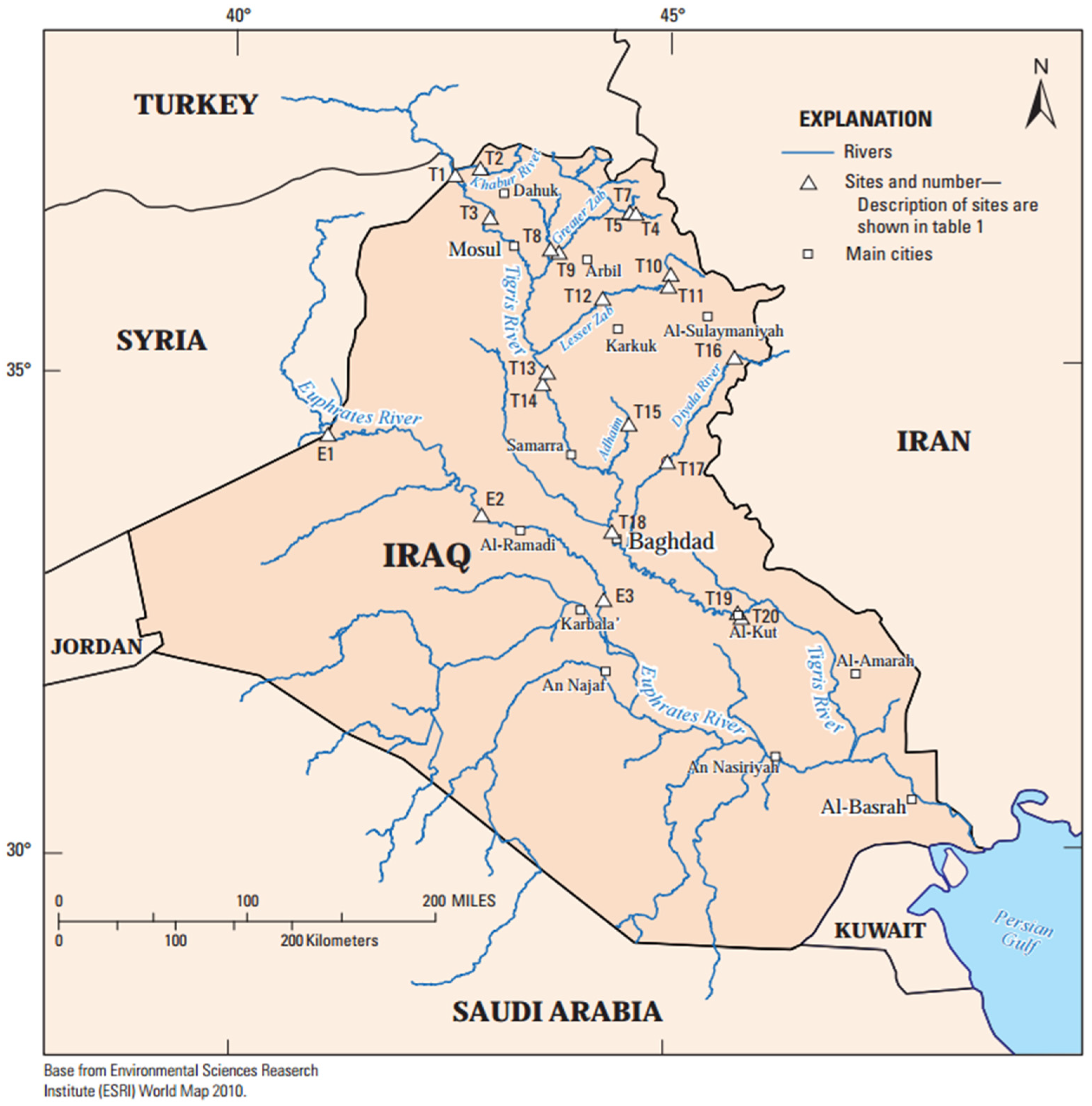

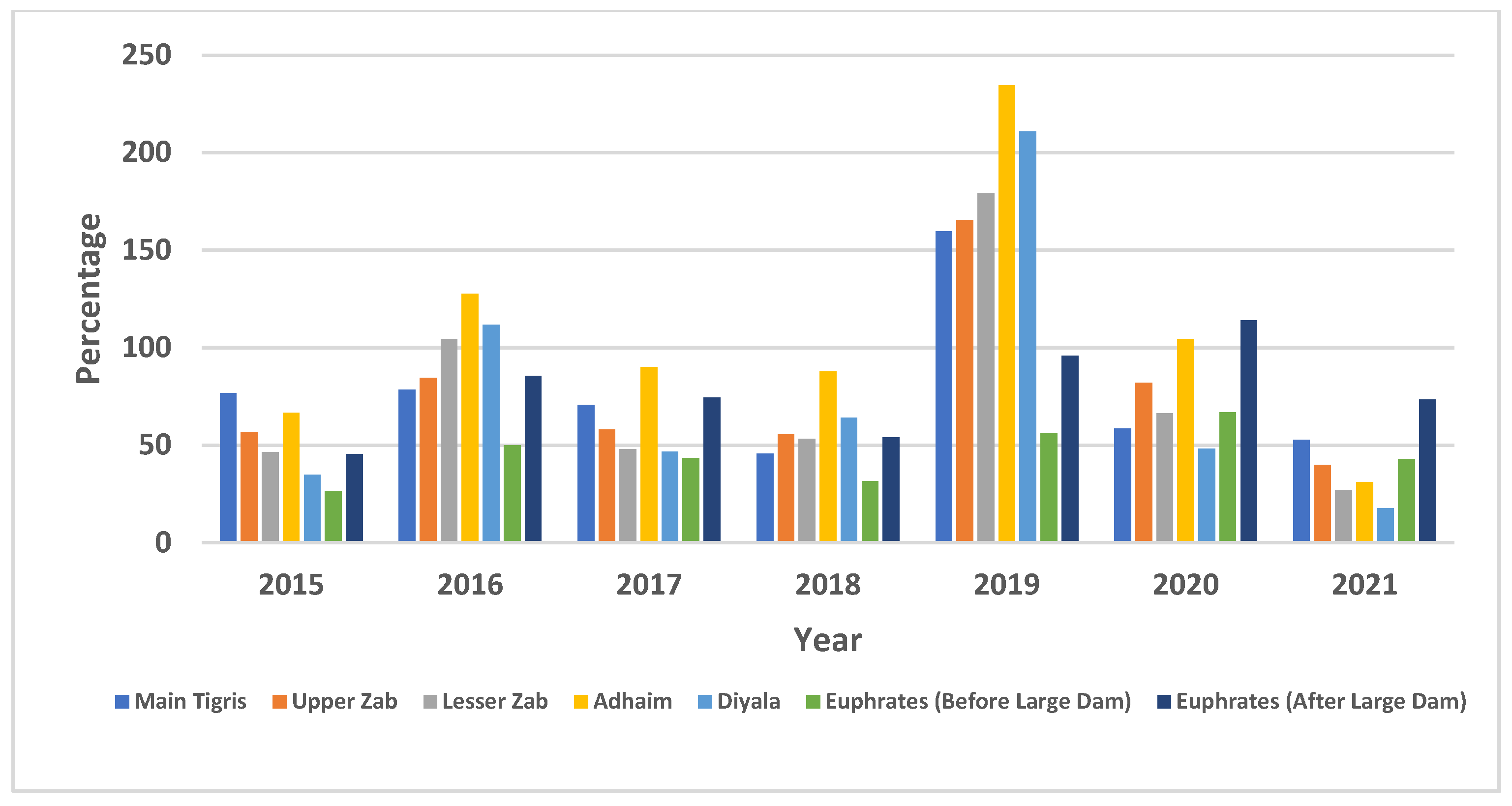

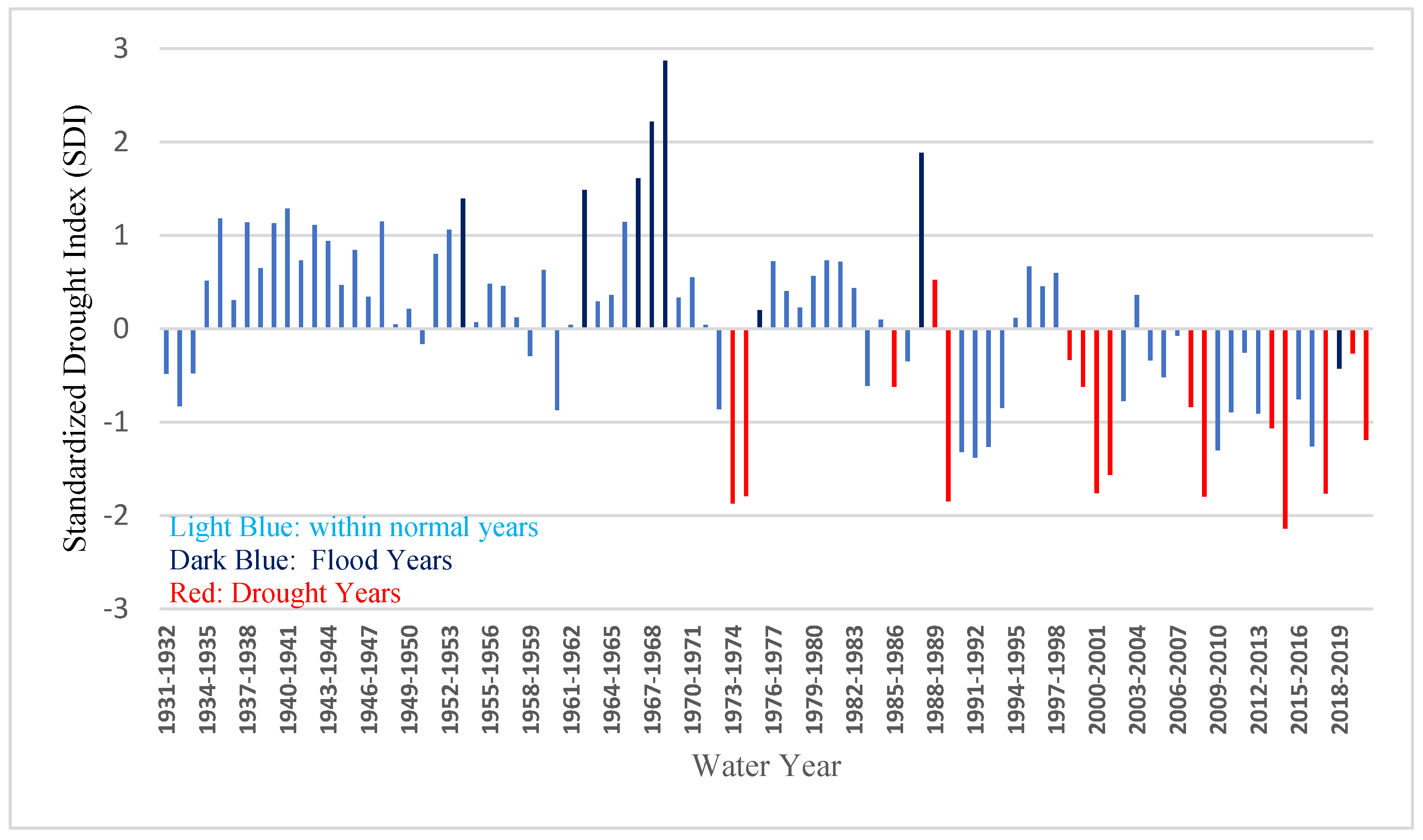

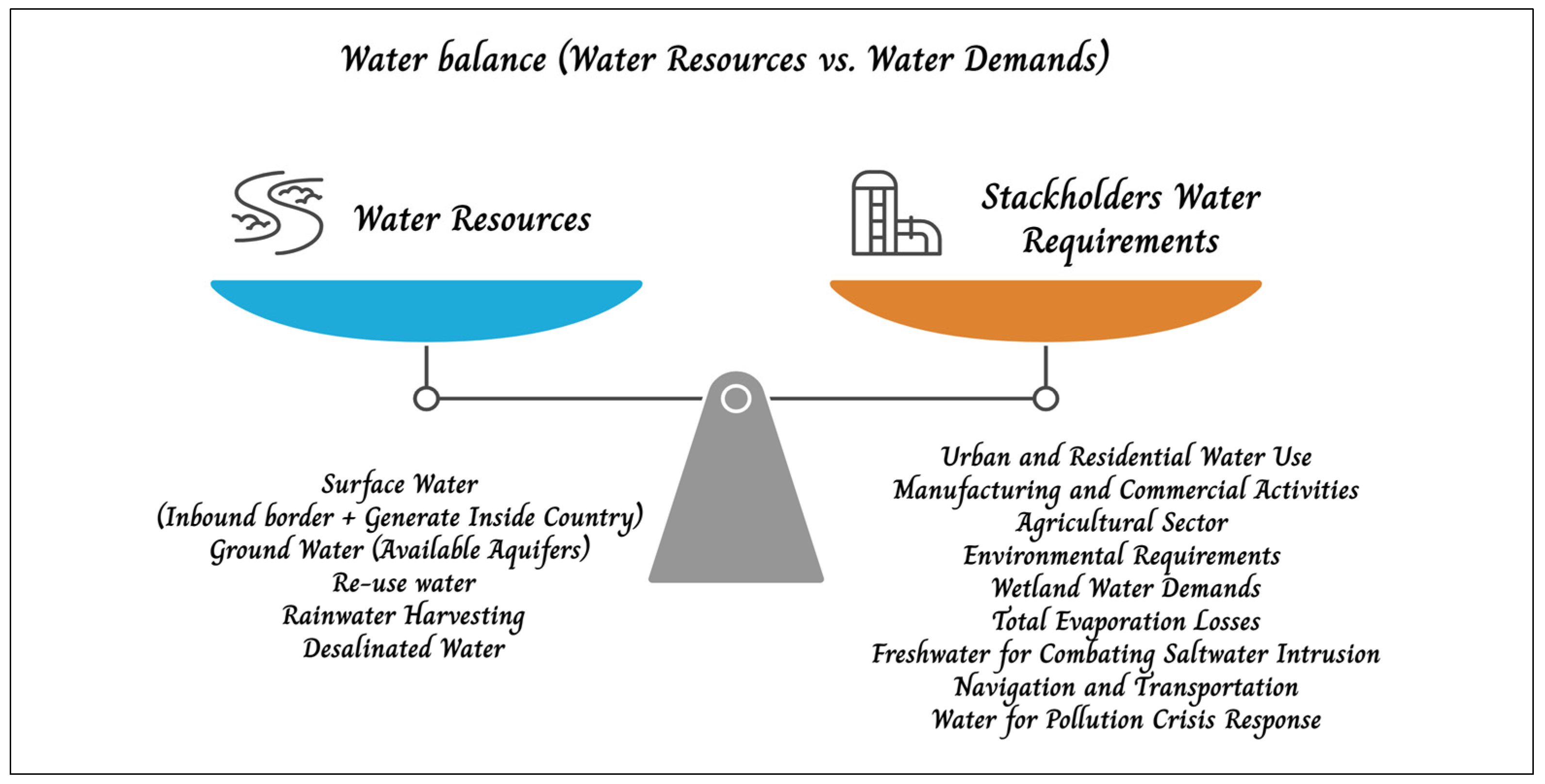

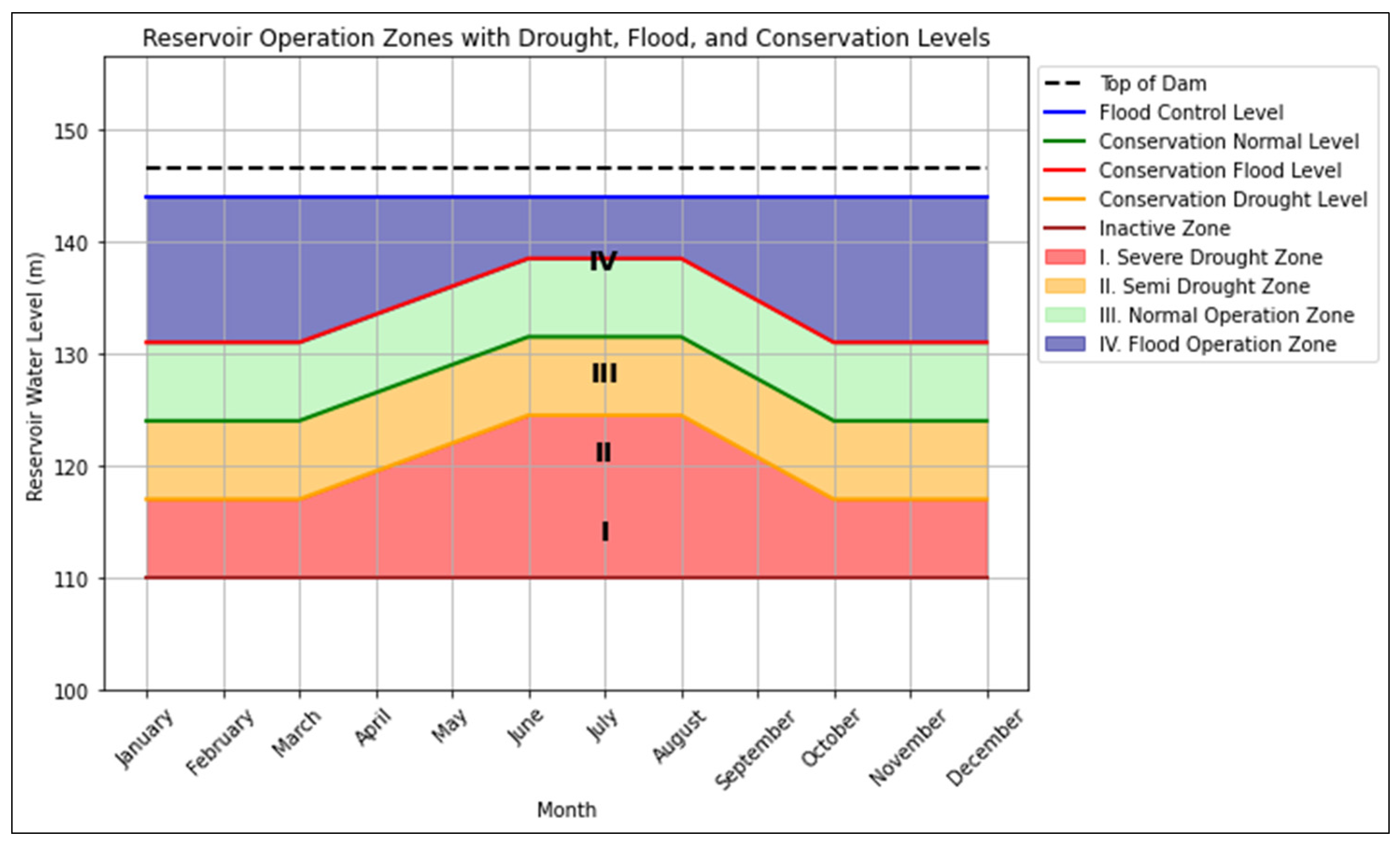
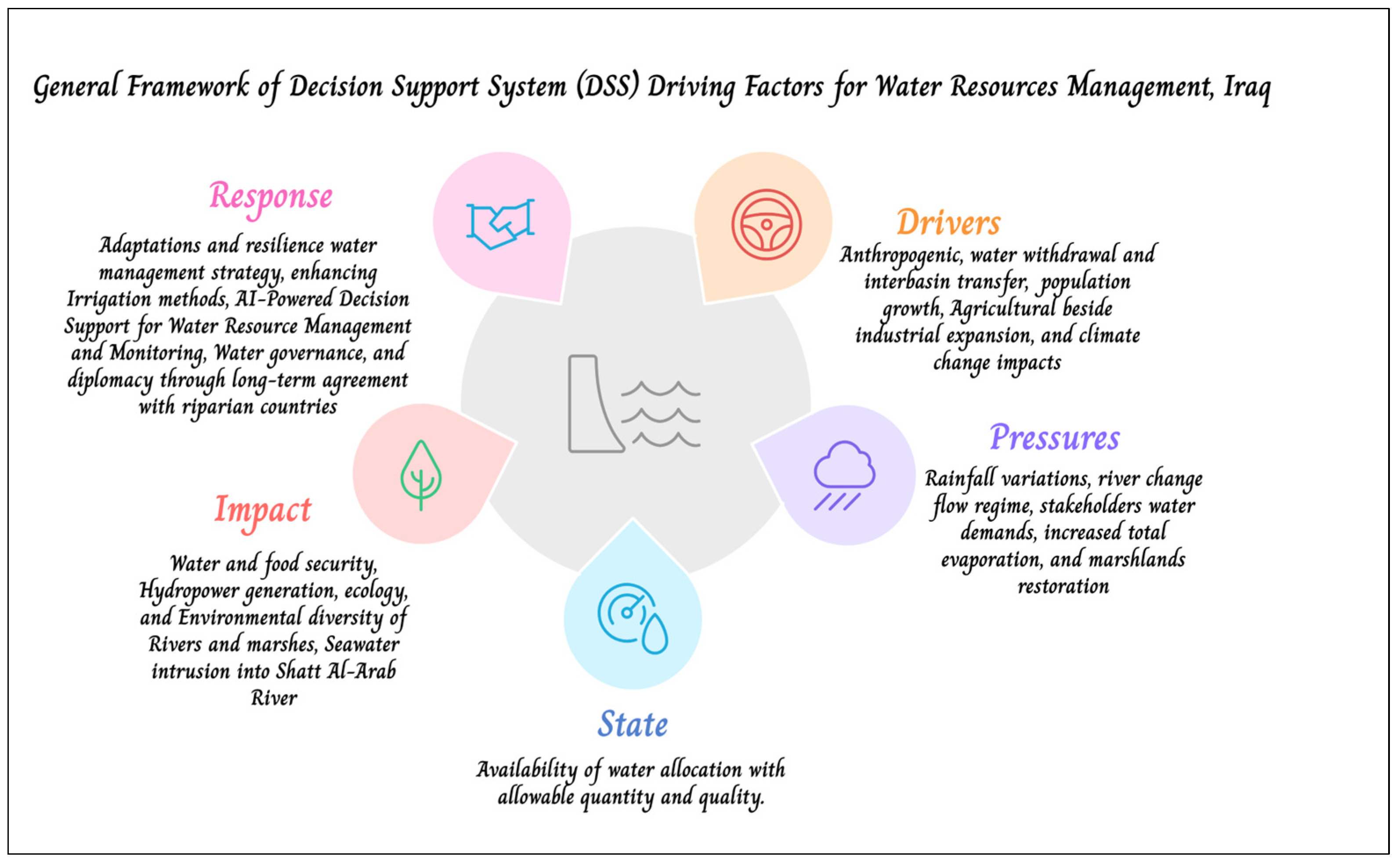
| Category | Details |
|---|---|
| (a) Objectives | 1. Food Security: Ensure adequate nutrition standards, considering population growth, declining soil conditions, and limited financial resources for food imports. 2. Internal Stability: Promote fair water distribution among stakeholders (farmers, industry, sanitation, environment), improve health standards, reduce local tensions, prevent migration, and ease pressures on local authorities. 3. International Relations: Avoid conflicts with riparian countries (Turkey, Iran, Syria) regarding Tigris and Euphrates water resources. |
| (b) Time Frame and Staging | A 25-year strategy (up to 2050), divided into five 5-year stages with annual reviews for updating data and monitoring progress. |
| (c) Scenarios for Consideration | 1. Climate Change Scenarios: Account for potential impacts on water availability. 2. Water Sharing Scenarios: Consider scenarios with or without fair water-sharing agreements with riparian countries (Turkey, Iran, Syria). |
| (d) Introduction and Use of DSS | 1. Implement a Decision Support System (DSS) for water resource management. 2. Consider an updated strategy: limitations and possibilities. The installation will start immediately, with full automation by 2050. |
| Factors | Descriptions |
|---|---|
| Driving Forces | Scarcity and limitation of water resources Climate zone variability and climate change impact Anthropogenic impact through excessive water withdrawal and inter-basin transfer Urbanization and industrial expansion, agricultural water demands, and population growth |
| Pressures | Rainfall variations Change in river flow regimes Increased flash floods and successive drought years Fulfilling the stakeholder’s water demands Increased total evaporation losses Environmental ecosystems |
| State | Current water resources’ status (quantity and quality) |
| Impacts | Surface and groundwater depletion Water and food security Soil salinity and land degradation Increasing conflict over water allocation among provinces Farmer and livestock migration Fish farming, reed, and papyrus beneficiaries Gross National Product (GNP) Hydropower generation Ecology and environmental diversity of rivers and marshes Seawater intrusion into Shatt Al-Arab |
| Responses | Adaptations and resilience strategies for climate change and anthropogenic impacts Optimization of multi-purpose reservoir operation strategies Evaluating the hydraulic structures and the requirement for new dams Regulators and water harvesting Flood, drought, and saltwater intrusion management Enhancing irrigation systems and efficiency through the rehabilitation of and improvement in irrigation projects Intelligent water infrastructure monitoring and management with SCADAs, in addition to water quality and environmental monitoring, integrating with remote sensing, GIS, and digital technologies. Developing multi-hazard and early warning systems (EWSs) associated with water resource management Reducing water encroachments Enhancing treatments of drainage and wastewater outflow Public awareness initiative for conservation of water resources Strengthening institutional and legal frameworks for water management Water governance and diplomacy through long-term agreements with riparian countries Collaborating with international organizations Consultation agencies, academic institutions, and private sector for sustainable water resources Management and development |
Disclaimer/Publisher’s Note: The statements, opinions and data contained in all publications are solely those of the individual author(s) and contributor(s) and not of MDPI and/or the editor(s). MDPI and/or the editor(s) disclaim responsibility for any injury to people or property resulting from any ideas, methods, instructions or products referred to in the content. |
© 2025 by the authors. Licensee MDPI, Basel, Switzerland. This article is an open access article distributed under the terms and conditions of the Creative Commons Attribution (CC BY) license (https://creativecommons.org/licenses/by/4.0/).
Share and Cite
AL-Hudaib, H.; Adamo, N.; Bene, K.; Ray, R.; Al-Ansari, N. Application of Decision Support Systems to Water Management: The Case of Iraq. Water 2025, 17, 1748. https://doi.org/10.3390/w17121748
AL-Hudaib H, Adamo N, Bene K, Ray R, Al-Ansari N. Application of Decision Support Systems to Water Management: The Case of Iraq. Water. 2025; 17(12):1748. https://doi.org/10.3390/w17121748
Chicago/Turabian StyleAL-Hudaib, Hayder, Nasrat Adamo, Katalin Bene, Richard Ray, and Nadhir Al-Ansari. 2025. "Application of Decision Support Systems to Water Management: The Case of Iraq" Water 17, no. 12: 1748. https://doi.org/10.3390/w17121748
APA StyleAL-Hudaib, H., Adamo, N., Bene, K., Ray, R., & Al-Ansari, N. (2025). Application of Decision Support Systems to Water Management: The Case of Iraq. Water, 17(12), 1748. https://doi.org/10.3390/w17121748








